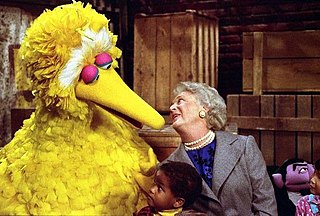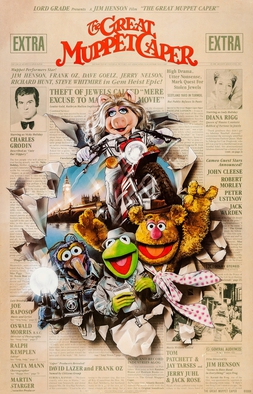Related Research Articles

James Maury Henson was an American puppeteer, animator, actor, and filmmaker who achieved worldwide notability as the creator of the Muppets. Henson was also well known for creating Fraggle Rock (1983–1987) and as the director of The Dark Crystal (1982) and Labyrinth (1986).

The Muppets are an American ensemble cast of puppet characters known for an absurdist, surrealist, burlesque, and self-referential style of variety-sketch comedy. Created by Jim Henson in 1955, they are the focus of a media franchise that encompasses children's films, television, music, and other media associated with the characters. Owned by the Jim Henson Company for nearly five decades, the characters and franchise were acquired by the Walt Disney Company in 2004.

The Muppet Show is a variety sketch comedy television series created by Jim Henson and starring the Muppets. The series originated as two pilot episodes produced by Henson for ABC in 1974 and 1975. While neither episode was moved forward as a series and other networks in the United States rejected Henson's proposals, British producer Lew Grade expressed enthusiasm for the project and agreed to co-produce The Muppet Show for the British station ATV. Five seasons, totalling 120 episodes, were broadcast on ATV and other ITV franchises in the United Kingdom and in first-run syndication in the United States from 1976 to 1981. The programme was produced and recorded at the ATV Elstree Studios in Borehamwood, Hertfordshire.

Big Bird is a Muppet character designed by Jim Henson and built by Kermit Love for the children's television show Sesame Street. An eight-foot-two-inch-tall (249 cm) bright yellow anthropomorphic bird, he can roller skate, ice skate, dance, swim, sing, write poetry, draw, and ride a unicycle. Despite this wide array of talents, he is prone to frequent misunderstandings, on one occasion even singing the alphabet as a single word. He would refer to grocer Mr. Hooper as "Mr. Looper", among other mispronunciations. He lives in a large nest behind the 123 Sesame Street brownstone and right next to Oscar the Grouch's trash can. In Season 46, the nest sits within a small, furnished maple tree, and is no longer hidden by used construction doors. He has a teddy bear named Radar.

Rowlf the Dog is a Muppet character created and originally performed by Jim Henson. Known most notably as the resident pianist on the sketch comedy television series The Muppet Show, Rowlf is a scruffy brown dog of indeterminate breed with a rounded black nose and long floppy ears. Laid-back and wisecracking, his humor is characterized as deadpan and as such, he is one of few Muppets who is rarely flustered by the show's prevalent mayhem. Henson's closest collaborators and family members have claimed Rowlf to be the Muppet character most similar to Henson's real-life personality.

The Jim Henson Company, formerly known as Muppets, Inc., Henson Associates, Inc., and Jim Henson Productions, Inc.; commonly referred to as Henson, is an American entertainment company located in Los Angeles, California. The company is known for its innovations in the field of puppetry, particularly through the creation of Kermit the Frog and the Muppets characters.

The Muppet Movie is a 1979 musical road comedy film directed by James Frawley and produced by Jim Henson, and the first theatrical film to feature the Muppets. A co-production between the United Kingdom and the United States, the film was written by The Muppet Show writers Jerry Juhl and Jack Burns. Produced during the third season of The Muppet Show, the film tells the origin story of the Muppets, as Kermit the Frog embarks on a cross-country trip to Los Angeles, encountering several of the Muppets—who all share the same ambition of finding success in professional show business—along the way while being pursued by Doc Hopper, a greedy restaurateur with intentions of employing Kermit as a spokesperson for his frog legs business.

The Muppets Take Manhattan is a 1984 American musical comedy-drama film directed by Frank Oz and the third theatrical film featuring the Muppets. The film stars Muppet performers Jim Henson, Oz, Dave Goelz, Steve Whitmire, Richard Hunt, Jerry Nelson, as well as special appearances by Art Carney, James Coco, Dabney Coleman, Gregory Hines, Linda Lavin, Liza Minnelli, Joan Rivers, and Brooke Shields. Filmed in New York City during the prior summer, it was released theatrically on July 13, 1984, by TriStar Pictures. A fantasy sequence in the film introduced the Muppet Babies, toddler versions of the lead Muppet characters.

The Muppet Christmas Carol is a 1992 American Christmas musical film directed by Brian Henson from a screenplay by Jerry Juhl. It is the fourth theatrical film featuring the Muppets. Adapted from the 1843 novella A Christmas Carol by Charles Dickens, the film stars Michael Caine as Ebenezer Scrooge, alongside Muppet performers Dave Goelz, Steve Whitmire, Jerry Nelson, and Frank Oz. Although artistic license is taken to suit the aesthetic of the Muppets, The Muppet Christmas Carol otherwise follows Dickens's original story closely. It is the first Muppet film to be produced following the deaths of Muppets creator Jim Henson and performer Richard Hunt; the film is dedicated to both.
Rizzo the Rat is a Muppet character from the sketch comedy television series The Muppet Show, created and originally performed by Steve Whitmire until 2016.

The Great Muppet Caper is a 1981 musical heist comedy film directed by Jim Henson and the second theatrical film featuring the Muppets. The film stars Muppet performers Henson, Frank Oz, Dave Goelz, Jerry Nelson, Richard Hunt, and Steve Whitmire, as well as Charles Grodin and Diana Rigg with special cameo appearances by John Cleese, Robert Morley, Peter Ustinov, and Jack Warden. The film was produced by ITC Entertainment and The Jim Henson Company and distributed by Universal Pictures. In the plot, the Muppets are caught up in a jewel heist while investigating a robbery in London.

"Rainbow Connection" is a song from the 1979 film The Muppet Movie, with music and lyrics written by Paul Williams and Kenneth Ascher. The song was performed by Jim Henson – as Kermit the Frog – in the film. "Rainbow Connection" reached No. 25 on the Billboard Hot 100 in November 1979, with the song remaining in the Top 40 for seven weeks in total. Williams and Ascher received an Academy Award nomination for Best Original Song at the 52nd Academy Awards.
Jane Ann Henson was an American puppeteer and co-founder of Muppets, Inc. with her husband Jim Henson.
John Paul Henson was an American puppeteer, best known for his association with the Muppets.

Wendy Froud is an American doll-artist, sculptor, puppet-maker, and writer. She is best known for her work fabricating Yoda for the 1980 film Star Wars: The Empire Strikes Back, for which she has been called "the mother of Yoda", and creatures for the Jim Henson films The Dark Crystal and Labyrinth.

Emmet Otter's Jug-Band Christmas is a 1977 television special directed by Jim Henson, based on the 1971 children's book of the same name by Russell Hoban, itself inspired by "The Gift of the Magi" by O. Henry. The special features characters from Hoban's novel, in a teleplay adapted by Jerry Juhl. The special features narration by Kermit the Frog, who tells the story of Emmet Otter and his widowed Ma, a poor family of otters who struggle to get Christmas presents for the other as a result of their financial situation. The special was produced by The Jim Henson Company and first premiered on CBC Television on December 4, 1977.

"Man or Muppet" is a song from Walt Disney Pictures' 2011 musical comedy film The Muppets, written by singer-songwriter Bret McKenzie. Performed by the film's main characters, Gary and Walter, the song also features Bill Barretta and Jim Parsons portraying the contrasting identities of Gary and Walter, respectively. The song was released by Walt Disney Records on November 22, 2011, as part of the film's original soundtrack.
The Muppets Go to the Movies is a one-hour television special starring Jim Henson's Muppets. It first aired May 20, 1981 on ABC as promotion for The Great Muppet Caper, which was released in the United States a month later.

The Muppet Movie: Original Soundtrack Recording is the soundtrack album from the 1979 film, The Muppet Movie, featuring the songs and select score written by Paul Williams and Kenneth Ascher. Originally released on LP by Atlantic Records in North America and by CBS internationally, the album reached No. 32 on the Billboard 200, and was certified Gold by the Recording Industry Association of America. The soundtrack won the Grammy Award for Best Children's Album in 1980 and was also nominated for the Grammy Award for Best Score Soundtrack for Visual Media, the Golden Globe for Best Original Song, and two Academy Awards; Best Adaptation Score for the overall album and Best Original Song for "Rainbow Connection", which reached No. 25 on the Billboard Hot 100.
References
- ↑ 1966|Oscars.org
- ↑ Ted Nemeth - IMDB
- ↑ Short Film Winners: 1966 Oscars
- ↑ Jim Henson: Before Happytime Murders, Muppet creator told edgy stories - Polygon
- ↑ Help! I Love Watching Animated Shorts|Animation World Network
- ↑ "Time Piece" - Short Film - Behind the Scenes - The Jim Henson Company on YouTube
- 1 2 3 4 5 6 7 8 9 Jones, Brian Jay (2013). "A Crazy Little Band". Jim Henson: The Biography. New York: Ballantine Books. pp. 110–113, 120. ISBN 978-0-345-52611-3.
- ↑ Campbell, Christopher (21 November 2011). "Short Starts: Watch Jim Henson's Oscar-Nominated "Time Piece"". IndieWire. Retrieved 15 October 2013.
- ↑ Epplin, Luke (24 September 2013). "Before the Muppets, Jim Henson Tried to Build a Futuristic Nightclub". The Atlantic. Retrieved 15 October 2013.
- ↑ Rudy Van Gelder - IMDB
- ↑ Oddball Films: The Conscious Clock: Perspectives on Time and Reality - Sat. Mar 10 - 8pm
- ↑ "'Heard that "Time Piece" nominated for Academy Award'". The Jim Henson Company. Jim Henson's Red Book. 17 February 2011. Archived from the original on 30 December 2013. Retrieved 15 October 2013.